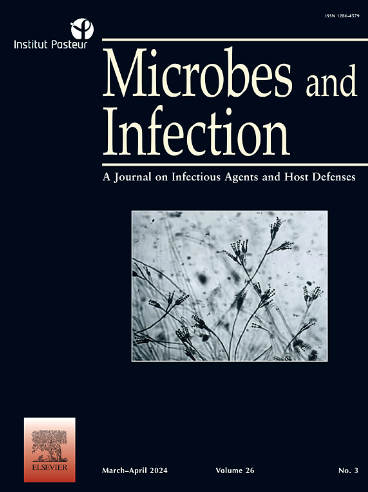canettii分枝杆菌和结核分枝杆菌的比较病理适应:从吞噬体酸化、细胞质通路和转录组学分析的见解。
IF 2.7
4区 医学
Q3 IMMUNOLOGY
引用次数: 0
摘要
结核分枝杆菌(Mtb)与其祖先对应的卡内蒂分枝杆菌(Mcan)之间的遗传和分子差异仍然知之甚少。我们的研究旨在比较它们对巨噬细胞吞噬体酸化和细胞质通路的调节,以及它们的体外转录组。利用荧光光谱法,我们追踪了THP-1巨噬细胞中含有分枝杆菌的液泡的pH变化。单细胞FRET方案评估了分枝杆菌在这些细胞中的细胞质通路。与Mtb类似,Mcan抑制吞噬体酸化并进入细胞质。转录组学和遗传学分析揭示了双组分系统(PhoPR、SenX3-RegX3和DevRS/DosRS)和特定基因(如乳酸脱氢酶和espACD)的突变驱动病原体之间基因表达的变化。此外,与Mtb相比,Mcan上调了铁和钼酸盐代谢基因,这表明金属在结核分枝杆菌的进化中发挥了作用。Mtb中终止因子Rho的上调也提示了反义转录和/或基因表达调控的差异。总之,巨噬细胞中的吞噬体调节和细胞质通路是MTBC出现之前的祖先特征,而不是Mtb严格的致病生活方式所独有的。此外,基因表达调控可能塑造了Mcan和Mtb之间的表型差异,促进了从环境类Mcan祖先到MTBC适应宿主生活方式的进化转变。本文章由计算机程序翻译,如有差异,请以英文原文为准。
Comparative pathoadaptation of Mycobacterium canettii and Mycobacterium tuberculosis: Insights from assays on phagosome acidification, cytosolic access, and transcriptomics
Genetic and molecular differences between Mycobacterium tuberculosis (Mtb) and its ancestral counterpart, Mycobacterium canettii (Mcan), remain poorly known. Our study aimed to compare their modulation of phagosome acidification and cytosolic access in macrophages, and their in vitro transcriptomes. Using spectrofluorometry, we tracked pH changes in mycobacteria-containing vacuoles in THP-1 macrophages. A single-cell FRET protocol evaluated cytosolic access of mycobacteria in these cells. Similar to Mtb, Mcan inhibits phagosome acidification and accesses the cytosol. Transcriptomic and genetic analyses reveal mutations in two-component systems (PhoPR, SenX3-RegX3, and DevRS/DosRS) and in specific genes (e.g., lactate dehydrogenase and espACD) driving variations in gene expression between pathogens. Moreover, Mcan upregulates genes of iron and molybdopterin metabolism compared to Mtb, suggesting a role for metals in the evolution of tuberculous mycobacteria. The upregulation of the termination factor Rho in Mtb also suggests differences in antisense transcription and/or gene expression regulation. In conclusion, phagosome modulation and cytosolic access in macrophages are ancestral traits predating the emergence of the MTBC and not exclusive to Mtb's strict pathogenic lifestyle. Additionally, gene expression regulation likely shaped the phenotypic differences between Mcan and Mtb, contributing to the evolutionary transition from an environmental Mcan-like ancestor to the MTBC's host-adapted lifestyle.
求助全文
通过发布文献求助,成功后即可免费获取论文全文。
去求助
来源期刊

Microbes and Infection
医学-病毒学
CiteScore
12.60
自引率
1.70%
发文量
90
审稿时长
40 days
期刊介绍:
Microbes and Infection publishes 10 peer-reviewed issues per year in all fields of infection and immunity, covering the different levels of host-microbe interactions, and in particular:
the molecular biology and cell biology of the crosstalk between hosts (human and model organisms) and microbes (viruses, bacteria, parasites and fungi), including molecular virulence and evasion mechanisms.
the immune response to infection, including pathogenesis and host susceptibility.
emerging human infectious diseases.
systems immunology.
molecular epidemiology/genetics of host pathogen interactions.
microbiota and host "interactions".
vaccine development, including novel strategies and adjuvants.
Clinical studies, accounts of clinical trials and biomarker studies in infectious diseases are within the scope of the journal.
Microbes and Infection publishes articles on human pathogens or pathogens of model systems. However, articles on other microbes can be published if they contribute to our understanding of basic mechanisms of host-pathogen interactions. Purely descriptive and preliminary studies are discouraged.
 求助内容:
求助内容: 应助结果提醒方式:
应助结果提醒方式:


